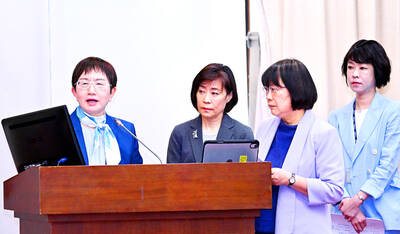The price of liquid-crystal-display (LCD) panels used in computers is expected to extend its recent uptrend through the current quarter as growing demand for monitor screens could help ease oversupply, market researcher DisplaySearch said yesterday.
But prices for TV panels are expected to dip even further before the third quarter as a weakening US economy and a snowstorm in China during Lunar New Year dampened TV sales, the Austin, Texas-based researcher said.
About one-third of the overall 80 million LCD TV shipments last year went to the North America, DisplaySearch said.
Monitor panels, however, were a different story.
“We think the price of monitor panels will rise through the second quarter after a US$3 price hike in March as TV makers are using more monitor panels in small size TVs,” DisplaySearch vice president David Hsieh (謝勤益) said yesterday on the sideline of an annual forum in Taipei.
TV makers are using primarily 19-inch and 22-inch monitor panels, although the panels are slightly darker than those in TVs and have a TV tuner to turn a desktop computer into a TV set, Hsieh said.
“This is a new and growing trend and has become an important factor behind the rarely-seen supply constraint in monitor panels,” Hsieh said.
About 6 percent of LCD monitor panels — or 13 million units — of a total 204 million monitor panels, will be used in TVs this year, up from about 4 percent last year, DisplaySearch said.
LG Display Co, the No. 2 flat panel maker, said the new monitor panel demand along with the rise of low-cost PCs would help alleviate oversupply of computer panels, said David Choi, a vice president at the Korean firm in Taipei.
LG Display intends to launch in July its 18.5-inch monitor panels for TVs, Choi said.
DisplaySearch said demand and supply of computer and TV panels would reach parity this quarter while a shortage would follow in the third quarter, a peak season.
Rival AU Optronics Co (友達光電) was also aware of the trend.
“The line between computers and TVs, with screen sizes between 20 inches and 30 inches, is blurring,” AU Optronics executive vice president Paul Peng (彭雙浪) said.
The Hsinchu-based company expected shipments of “monitor TVs” to triple in the next five years.
To match growing demand for people with lower incomes or in emerging markets, AU Optronics said it would roll out a new series of monitor panels for TVs with sizes ranging from 18.5 inches to 31.5 inch in the second half.
In contrast to an apparently rosy outlook for monitor panels, Hsieh said, “Oversupply in the past few months has been worse than we anticipated. Demand for TVs disappointed because of the recession in the US and a snowstorm storm in China.”
Unlike DisplaySearch’s projections, a TV panel shortage did not happen in the current quarter, Hsieh said.
Reflecting dwindling demand for TVs, the price of TV panels dropped 2 percent this month and will not stabilize until the third quarter, he said.
Peng said, however, that “So far demand for TV panels has been good,” adding that recent price cuts of TV sets in the US would spur more demand.

‘SWASTICAR’: Tesla CEO Elon Musk’s close association with Donald Trump has prompted opponents to brand him a ‘Nazi’ and resulted in a dramatic drop in sales Demonstrators descended on Tesla Inc dealerships across the US, and in Europe and Canada on Saturday to protest company chief Elon Musk, who has amassed extraordinary power as a top adviser to US President Donald Trump. Waving signs with messages such as “Musk is stealing our money” and “Reclaim our country,” the protests largely took place peacefully following fiery episodes of vandalism on Tesla vehicles, dealerships and other facilities in recent weeks that US officials have denounced as terrorism. Hundreds rallied on Saturday outside the Tesla dealership in Manhattan. Some blasted Musk, the world’s richest man, while others demanded the shuttering of his

ADVERSARIES: The new list includes 11 entities in China and one in Taiwan, which is a local branch of Chinese cloud computing firm Inspur Group The US added dozens of entities to a trade blacklist on Tuesday, the US Department of Commerce said, in part to disrupt Beijing’s artificial intelligence (AI) and advanced computing capabilities. The action affects 80 entities from countries including China, the United Arab Emirates and Iran, with the commerce department citing their “activities contrary to US national security and foreign policy.” Those added to the “entity list” are restricted from obtaining US items and technologies without government authorization. “We will not allow adversaries to exploit American technology to bolster their own militaries and threaten American lives,” US Secretary of Commerce Howard Lutnick said. The entities

Taiwan’s official purchasing managers’ index (PMI) last month rose 0.2 percentage points to 54.2, in a second consecutive month of expansion, thanks to front-loading demand intended to avoid potential US tariff hikes, the Chung-Hua Institution for Economic Research (CIER, 中華經濟研究院) said yesterday. While short-term demand appeared robust, uncertainties rose due to US President Donald Trump’s unpredictable trade policy, CIER president Lien Hsien-ming (連賢明) told a news conference in Taipei. Taiwan’s economy this year would be characterized by high-level fluctuations and the volatility would be wilder than most expect, Lien said Demand for electronics, particularly semiconductors, continues to benefit from US technology giants’ effort

Minister of Finance Chuang Tsui-yun (莊翠雲) yesterday told lawmakers that she “would not speculate,” but a “response plan” has been prepared in case Taiwan is targeted by US President Donald Trump’s reciprocal tariffs, which are to be announced on Wednesday next week. The Trump administration, including US Secretary of the Treasury Scott Bessent, has said that much of the proposed reciprocal tariffs would focus on the 15 countries that have the highest trade surpluses with the US. Bessent has referred to those countries as the “dirty 15,” but has not named them. Last year, Taiwan’s US$73.9 billion trade surplus with the US